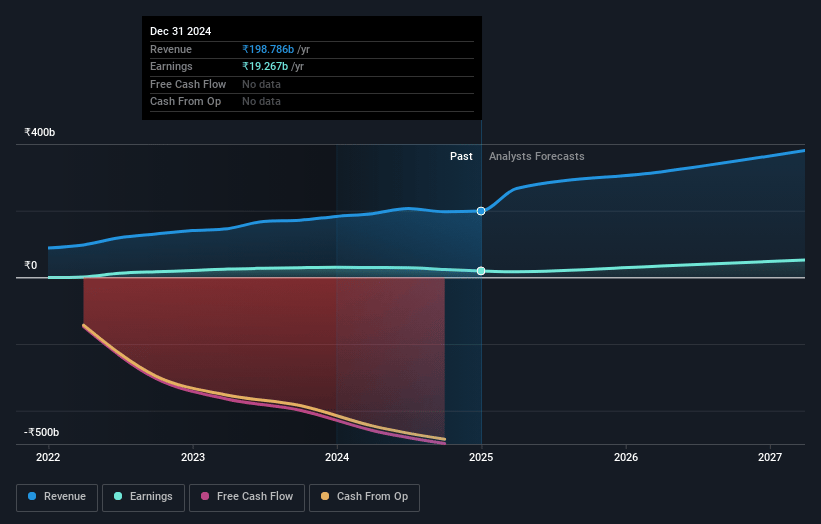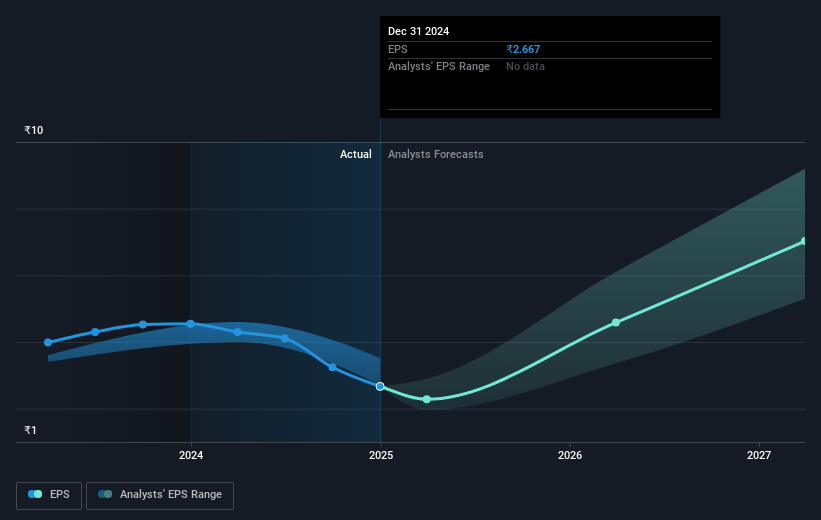Key Takeaways
- Strategic expansion in credit cards and wealth management could boost profitability due to rapid growth and cross-selling potential.
- Streamlining operational expenses and focus on CASA deposits could enhance net margins and establish a stable funding base.
- IDFC First Bank faces potential margin pressure and profitability challenges due to high-cost borrowings, credit costs, and reliance on reducing operating expenses.
Catalysts
About IDFC First Bank- Engages in the provision of various banking and financial services to corporates, individuals, multi-national companies, SMEs/entrepreneurs, financial institutions, and the government in India.
- The high cost of building the branch infrastructure is expected to reduce over time, potentially leading to improved net margins as the bank scales and reduces its ongoing setup expenses.
- Strategic growth in retail and wholesale deposits, with a focus on CASA deposits, could drive future revenue increases as the bank establishes a stable, low-cost funding base.
- The reduction of high-cost legacy borrowings could lead to lower interest expenses, thereby increasing net interest margins and improving earnings over time.
- Expansion in high-margin segments like credit cards and wealth management could significantly enhance profitability and boost future revenue, given their current rapid growth rates and potential for cross-selling.
- Efforts to control and reduce operational expenses while maintaining growth, indicated by goals to stabilize expenditures, could improve cost-to-income ratios and subsequently enhance net margins.
IDFC First Bank Future Earnings and Revenue Growth
Assumptions
How have these above catalysts been quantified?- Analysts are assuming IDFC First Bank's revenue will grow by 31.2% annually over the next 3 years.
- Analysts assume that profit margins will increase from 9.7% today to 15.0% in 3 years time.
- Analysts expect earnings to reach ₹67.4 billion (and earnings per share of ₹9.23) by about April 2028, up from ₹19.3 billion today.
- In order for the above numbers to justify the analysts price target, the company would need to trade at a PE ratio of 11.9x on those 2028 earnings, down from 26.0x today. This future PE is greater than the current PE for the IN Banks industry at 10.9x.
- Analysts expect the number of shares outstanding to grow by 3.54% per year for the next 3 years.
- To value all of this in today's terms, we will use a discount rate of 14.0%, as per the Simply Wall St company report.
IDFC First Bank Future Earnings Per Share Growth
Risks
What could happen that would invalidate this narrative?- High-cost legacy borrowings and rising credit costs in the MFI segment pose risks that can pressure net margins and profitability.
- The bank's high cost-to-income ratio and reliance on reducing operating expenses over time could challenge earnings growth if cost reductions are not realized.
- Dependence on MFI for meeting regulatory PSL requirements exposes the bank to sector-specific risks, potentially impacting revenue if adverse conditions persist.
- IDFC First Bank's strategy of building new businesses like credit cards and wealth management may incur initial losses, affecting short-term profit levels.
- Increased competition in the rapid growth of retail deposits could hinder the bank's ability to maintain competitive net interest margins.
Valuation
How have all the factors above been brought together to estimate a fair value?- The analysts have a consensus price target of ₹66.368 for IDFC First Bank based on their expectations of its future earnings growth, profit margins and other risk factors. However, there is a degree of disagreement amongst analysts, with the most bullish reporting a price target of ₹85.0, and the most bearish reporting a price target of just ₹48.0.
- In order for you to agree with the analyst's consensus, you'd need to believe that by 2028, revenues will be ₹449.1 billion, earnings will come to ₹67.4 billion, and it would be trading on a PE ratio of 11.9x, assuming you use a discount rate of 14.0%.
- Given the current share price of ₹68.48, the analyst price target of ₹66.37 is 3.2% lower. The relatively low difference between the current share price and the analyst consensus price target indicates that they believe on average, the company is fairly priced.
- We always encourage you to reach your own conclusions though. So sense check these analyst numbers against your own assumptions and expectations based on your understanding of the business and what you believe is probable.
How well do narratives help inform your perspective?
Disclaimer
Warren A.I. is a tool utilizing a Large Language Model (LLM) that ingests data on consensus price targets, forecasted revenue and earnings figures, as well as the transcripts of earnings calls to produce qualitative analysis. The narratives produced by Warren A.I. are general in nature and are based solely on analyst data and publicly-available material published by the respective companies. These scenarios are not indicative of the company's future performance and are exploratory in nature. Simply Wall St has no position in the company(s) mentioned. Simply Wall St may provide the securities issuer or related entities with website advertising services for a fee, on an arm's length basis. These relationships have no impact on the way we conduct our business, the content we host, or how our content is served to users. The price targets and estimates used are consensus data, and do not constitute a recommendation to buy or sell any stock, and they do not take account of your objectives, or your financial situation. Note that Warren A.I.'s analysis may not factor in the latest price-sensitive company announcements or qualitative material.




